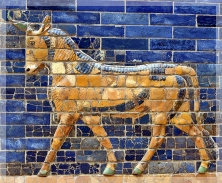God brought him forth out of Egypt; he hath as it were the strength of an unicorn: he shall eat up the nations his enemies, and shall break their bones, and pierce them through with his arrows. [Numbers 24:8 (KJV)]
 Some believers insist that unicorns actually existed because they are mentioned nine times in the Old Testament. Claiming the Bible is completely without error, they insist that you must believe the same thing—including the unicorns! On the other hand, some people disparage believers and discount all of Scripture because of those same unicorns! Do we blindly believe or do we “throw out the baby with the bathwater” because of one word?
Some believers insist that unicorns actually existed because they are mentioned nine times in the Old Testament. Claiming the Bible is completely without error, they insist that you must believe the same thing—including the unicorns! On the other hand, some people disparage believers and discount all of Scripture because of those same unicorns! Do we blindly believe or do we “throw out the baby with the bathwater” because of one word?
While the Bible is infallible, that’s not always true of translators. The Hebrew word used for this wild animal was re’em and seemed to mean a beast with a horn (but not necessarily only one horn). It’s found in Numbers 23:22, 24:8; Deuteronomy 33:17; Job 39:9,10; Psalm 22:21, 29:6, 92:10; and Isaiah 34:7. When looking at the context, re’em always refers to someone or something with great power. In Numbers, we find God comparing His strength to that of the re’em and, in Psalm 22:21, David refers to his formidable enemies as re’em.
By the third century BC, the language and culture of Greece had spread throughout the world and the Jewish knowledge of Hebrew was declining. The Jewish community in Egypt (along with the Hellenic Egyptian ruler Ptolemy II) initiated the translation of the Torah into Greek. During the next two centuries, the entirety of the Hebrew Scriptures were translated into Greek in what is called the Septuagint. At that time, the Hebrew re’em (wild beast with a horn) was inaccurately translated into the Greek monokeros (one horn). When citing the Hebrew Scriptures, the epistle writers quoted from the Septuagint and, since Gentile Christians knew nothing of Hebrew, the Greek Septuagint became the Bible of the early church.
Fast forward to the fourth century when Latin began replacing Greek as the language of the people. In 382 AD, Pope Damasus I commissioned his secretary, Jerome, to produce a new Scripture translation in Latin. Written in the Latin of the day, St. Jerome’s translation is known as the Vulgate. It is from this translation that we get English words like scripture, salvation, justification, and regeneration. In Jerome’s translation, the Greek monokeros became the Latin unicornis (a one-horned beast).
Fast forward again to the 16th century and the first English translations of Scripture—William Tyndale’s and the Geneva Bibles followed by the King James version in 1611. Although unicornis was rendered as unicorn in these Bibles, it’s unlikely the translators believed it to be the mythological unicorn. Not knowing what it was, they simply transliterated the Latin word into the English “unicorn.” Closely associated with chivalry, by the 1600s the unicorn was a symbol of purity and grace that could be captured only by a virgin. The horse-with-a-horn of myths and fairy tales doesn’t sound much like the untamable, ferocious, and powerful wild re’em of the Old Testament!
Nowadays, only a few Bible translations continue to use unicorn. I found only six (out of 62) and all of those are based on the Wycliff, Geneva, or King James translations. While most other versions translate re’em, monokeros, or unicornis as wild ox, a few use wild bull, rhinoceros, or buffalo. Since no one knows absolutely for sure, Young’s Literal translation returns to the original with reem! The Orthodox Jewish Bible uses wild bull, wild ox, and “re’eim (wild ox).”
So, what was the re’em? While it could refer to rhinoceros, buffalo, or antelope, it probably refers to aurochs, large cattle which once roamed Europe, Africa, and Asia. Ancient Assyrian and other Middle Eastern texts refer to this this wild ox-like animal with a similar word. Because ancient art usually depicted the auroch from a profile view (as does the ancient mosaic pictured), it appeared to have just one horn. Ancestors of domestic cattle, aurochs stood over six-feet tall and weighed over 2,200 pounds. Julius Caesar described them as “a little below the elephant in size,” having the shape and appearance of a horned bull, possessing “extraordinary” strength and speed, and being untamable, even when taken as calves. The auroch became extinct in Poland in 1627.
While we now have an answer to skeptics who mock us for believing in a book attesting to the existence of unicorns (when it doesn’t), we must be cautious in our response. Although Scripture doesn’t speak of a unicorn, that doesn’t mean some creature with just one horn never existed. After all, God created the one-horned narwal and rhinoceros, so who are we to say He never created something like the mythical unicorn? Although we’ve never seen them, we know animals like the wooly mammoth, dodo, saber-toothed tiger, and auroch existed. Having already seen strange creatures like jelly fish, giant anteaters, and the wildebeest, I know better than to deny God’s ability to create any creature He desires. What we can know for sure, however, is that the Bible can be trusted!
There’s no better book with which to defend the Bible than the Bible itself. [D.L. Moody]
